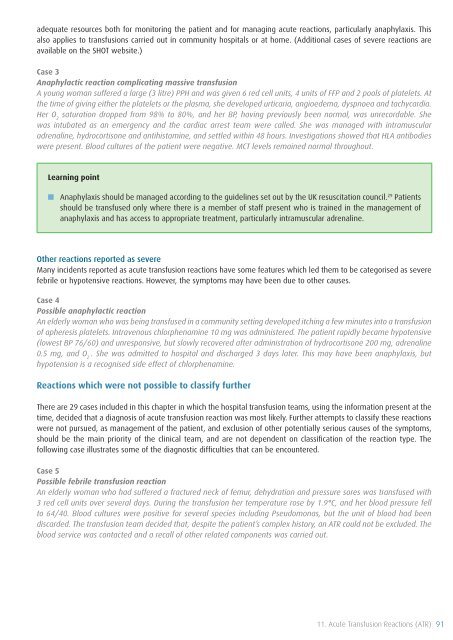SHOT Annual Report 2009 - Serious Hazards of Transfusion
SHOT Annual Report 2009 - Serious Hazards of Transfusion
SHOT Annual Report 2009 - Serious Hazards of Transfusion
You also want an ePaper? Increase the reach of your titles
YUMPU automatically turns print PDFs into web optimized ePapers that Google loves.
adequate resources both for monitoring the patient and for managing acute reactions, particularly anaphylaxis. This<br />
also applies to transfusions carried out in community hospitals or at home. (Additional cases <strong>of</strong> severe reactions are<br />
available on the <strong>SHOT</strong> website.)<br />
Case 3<br />
Anaphylactic reaction complicating massive transfusion<br />
A young woman suffered a large (3 litre) PPH and was given 6 red cell units, 4 units <strong>of</strong> FFP and 2 pools <strong>of</strong> platelets. At<br />
the time <strong>of</strong> giving either the platelets or the plasma, she developed urticaria, angioedema, dyspnoea and tachycardia.<br />
Her O 2<br />
saturation dropped from 98% to 80%, and her BP, having previously been normal, was unrecordable. She<br />
was intubated as an emergency and the cardiac arrest team were called. She was managed with intramuscular<br />
adrenaline, hydrocortisone and antihistamine, and settled within 48 hours. Investigations showed that HLA antibodies<br />
were present. Blood cultures <strong>of</strong> the patient were negative. MCT levels remained normal throughout.<br />
Learning point<br />
■■<br />
29<br />
Anaphylaxis should be managed according to the guidelines set out by the UK resuscitation council. Patients<br />
should be transfused only where there is a member <strong>of</strong> staff present who is trained in the management <strong>of</strong><br />
anaphylaxis and has access to appropriate treatment, particularly intramuscular adrenaline.<br />
Other reactions reported as severe<br />
Many incidents reported as acute transfusion reactions have some features which led them to be categorised as severe<br />
febrile or hypotensive reactions. However, the symptoms may have been due to other causes.<br />
Case 4<br />
Possible anaphylactic reaction<br />
An elderly woman who was being transfused in a community setting developed itching a few minutes into a transfusion<br />
<strong>of</strong> apheresis platelets. Intravenous chlorphenamine 10 mg was administered. The patient rapidly became hypotensive<br />
(lowest bp 76/60) and unresponsive, but slowly recovered after administration <strong>of</strong> hydrocortisone 200 mg, adrenaline<br />
0.5 mg, and O 2<br />
. She was admitted to hospital and discharged 3 days later. This may have been anaphylaxis, but<br />
hypotension is a recognised side effect <strong>of</strong> chlorphenamine.<br />
Reactions which were not possible to classify further<br />
There are 29 cases included in this chapter in which the hospital transfusion teams, using the information present at the<br />
time, decided that a diagnosis <strong>of</strong> acute transfusion reaction was most likely. Further attempts to classify these reactions<br />
were not pursued, as management <strong>of</strong> the patient, and exclusion <strong>of</strong> other potentially serious causes <strong>of</strong> the symptoms,<br />
should be the main priority <strong>of</strong> the clinical team, and are not dependent on classification <strong>of</strong> the reaction type. The<br />
following case illustrates some <strong>of</strong> the diagnostic difficulties that can be encountered.<br />
Case 5<br />
Possible febrile transfusion reaction<br />
An elderly woman who had suffered a fractured neck <strong>of</strong> femur, dehydration and pressure sores was transfused with<br />
3 red cell units over several days. During the transfusion her temperature rose by 1.9°C, and her blood pressure fell<br />
to 64/40. Blood cultures were positive for several species including Pseudomonas, but the unit <strong>of</strong> blood had been<br />
discarded. The transfusion team decided that, despite the patient’s complex history, an ATR could not be excluded. The<br />
blood service was contacted and a recall <strong>of</strong> other related components was carried out.<br />
11. Acute <strong>Transfusion</strong> Reactions (ATR) 91












